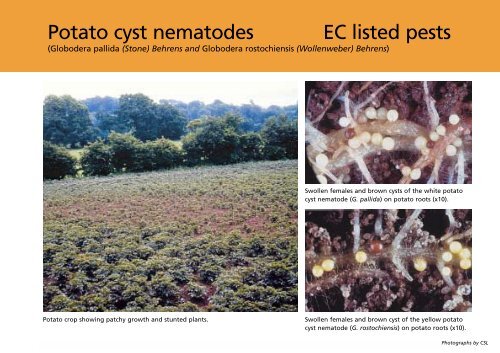Potato cyst nematodes (PDF 77KB)
Potato cyst nematodes (PDF 77KB)
Potato cyst nematodes (PDF 77KB)
Create successful ePaper yourself
Turn your PDF publications into a flip-book with our unique Google optimized e-Paper software.
<strong>Potato</strong> <strong>cyst</strong> <strong>nematodes</strong> EC listed pests<br />
(Globodera pallida (Stone) Behrens and Globodera rostochiensis (Wollenweber) Behrens)<br />
<strong>Potato</strong> crop showing patchy growth and stunted plants.<br />
Swollen females and brown <strong>cyst</strong>s of the white potato<br />
<strong>cyst</strong> nematode (G. pallida) on potato roots (x10).<br />
Swollen females and brown <strong>cyst</strong> of the yellow potato<br />
<strong>cyst</strong> nematode (G. rostochiensis) on potato roots (x10).<br />
Photographs by CSL
<strong>Potato</strong> <strong>cyst</strong> <strong>nematodes</strong> EC listed pests<br />
(Globodera pallida (Stone) Behrens and Globodera rostochiensis (Wollenweber) Behrens)<br />
HOSTS: <strong>Potato</strong> is the most important host for both<br />
Globodera pallida (the white potato <strong>cyst</strong> nematode) and G.<br />
rostochiensis (the yellow potato <strong>cyst</strong> nematode). However,<br />
potato <strong>cyst</strong> <strong>nematodes</strong> (PCN) also attack other solanaceous<br />
plants, e.g. tomato, aubergine and, occasionally, weeds<br />
such as bittersweet (Solanum dulcamara). Each species of<br />
PCN has several pathotypes; these differ in their ability to<br />
multiply on different potato cultivars.<br />
DISTRIBUTION: Widespread in Europe, including the UK;<br />
also South America, where they originated. Present to a<br />
more limited extent in all other continents. The number<br />
and range of pathotypes vary from country to country.<br />
SOURCES: Mainly introduced by <strong>cyst</strong>s of the nematode<br />
in soil attached to potato tubers, farm machinery or<br />
footwear; they are only rarely introduced by infested<br />
tubers. Cysts are also spread locally by wind and flood<br />
water.<br />
DESCRIPTION AND LIFE CYCLE: The juveniles and adult<br />
male <strong>nematodes</strong> are worm-like, less than 1 mm long and<br />
transparent. They feed within the roots and are not easily<br />
seen. As each female matures it swells and becomes almost<br />
spherical, bursting through the root wall. Only the head of<br />
the female remains embedded in the root. The swollen<br />
female is shiny, spherical, less than 1 mm in diameter and<br />
initially white or cream-coloured. The female of G.<br />
rostochiensis passes through a prolonged golden-yellow<br />
phase as it matures. When the female of either species dies,<br />
its body forms a dark, reddish-brown <strong>cyst</strong> with a hard skin.<br />
Each <strong>cyst</strong> usually contains 200–600 eggs. If infested plants<br />
© Crown copyright 2003<br />
PB 7291<br />
Ref. no.<br />
QIC/65<br />
are lifted carefully, the swollen females or the <strong>cyst</strong>s appear<br />
as small bead-like objects attached to the roots. With severe<br />
infestations, <strong>cyst</strong>s may occasionally be seen on the surface<br />
of tubers.<br />
At harvest, most <strong>cyst</strong>s become detached from the roots and<br />
remain in the soil as a source of infestation for future<br />
potato crops. In the absence of host plants, most eggs hatch<br />
within 7 years, and the population declines. However, some<br />
eggs remain viable in the soil for 10 or more years.<br />
A related species, Globodera achilleae, attacks yarrow<br />
(Achillea millefolium), which is found in meadows,<br />
hedgerows and field margins. Therefore, care is needed in<br />
the laboratory diagnosis of <strong>cyst</strong>s.<br />
DAMAGE: The <strong>nematodes</strong> damage the roots and reduce<br />
yield, even when infestations produce no obvious<br />
symptoms in the haulm. With severe infestations, roots are<br />
more seriously damaged and may be killed. Severely<br />
infested plants are stunted, often chlorotic and typically<br />
occur in patches. Rhizoctonia and other fungal diseases<br />
associated with nematode feeding may also contribute to<br />
the yield loss.<br />
PEST STATUS: <strong>Potato</strong> <strong>cyst</strong> <strong>nematodes</strong> (Globodera pallida<br />
and G. rostochiensis) are serious pests and are listed in EC<br />
plant health legislation. Inform your local Plant Health<br />
Inspector if you: are planning to grow seed potatoes; are<br />
registered to issue plant passports for bulbs, nursery stock<br />
or other transplants; or are planning to export ware<br />
potatoes or any of the above products to a non-EU country.<br />
Central Science Laboratory,<br />
Sand Hutton, York YO41<br />
1LZ<br />
Text prepared by CSL

















